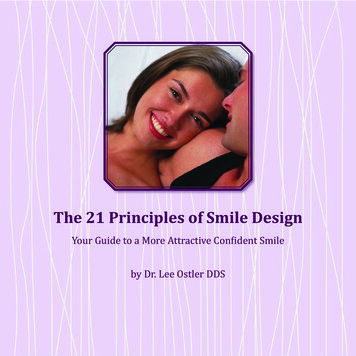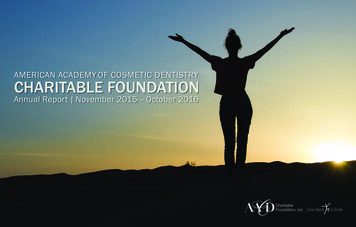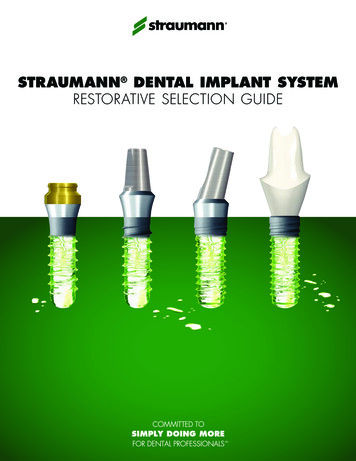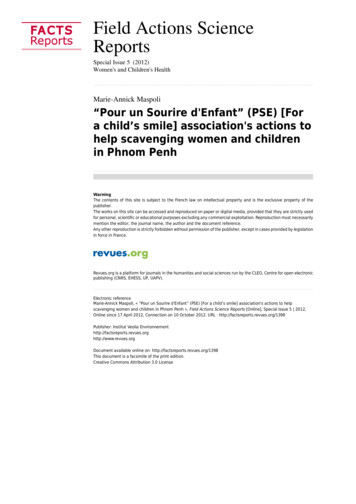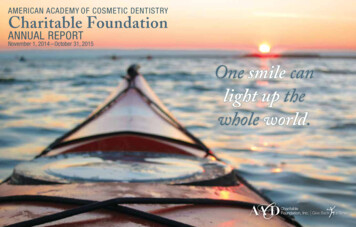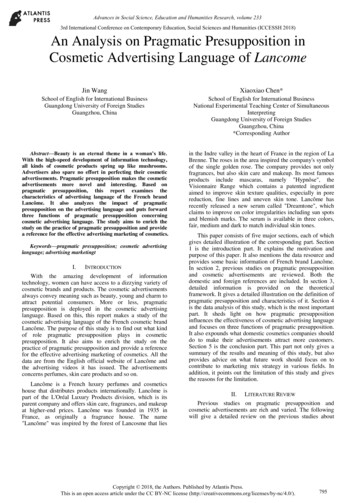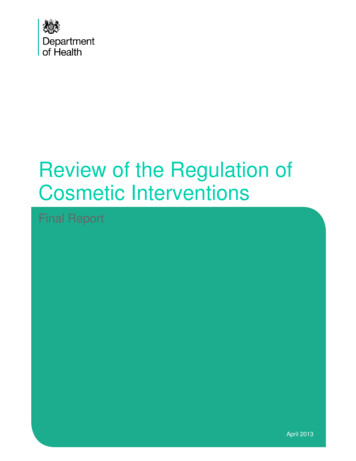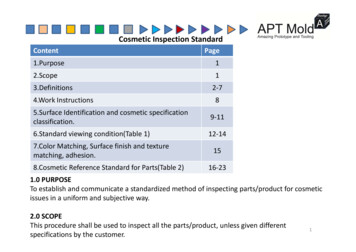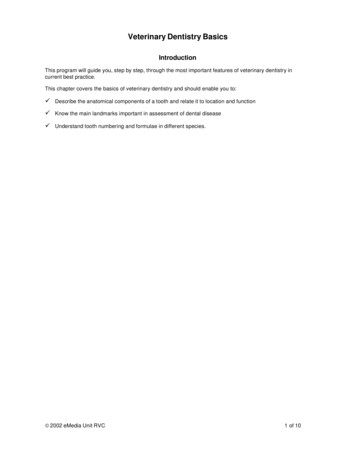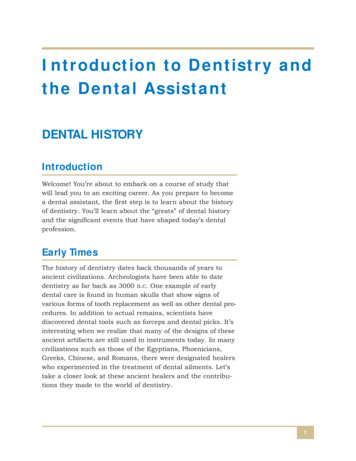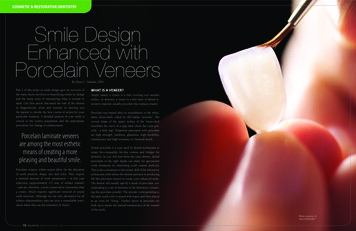
Transcription
COSMETIC & RESTORATIVE DENTISTRYSmile DesignEnhanced withPorcelain VeneersBy Dean C. Vafiadis, DDSPart 1 of this series on smile design gave an overview ofthe many facets involved in beautifying smiles by designand the many ways of interpreting what is normal orideal. Our first article discussed the role of the dentistas diagnostician, artist and scientist in meeting youthe patient to decide the best course of action for yourparticular situation. A detailed analysis of your smile iscritical to the correct assessment and the appropriateprocedures for change or enhancement.Porcelain laminate veneersare among the most estheticmeans of creating a morepleasing and beautiful smile.Porcelain veneers within reason allow for the alterationof tooth position, shape, size and color. They requirea minimal amount of tooth preparation – in this casereduction (approximately 0.5 mm of surface enamel)– and are, therefore, a more conservative restoration thana crown, which requires significant removal of soundtooth structure. Although not the only alternative for allesthetic abnormalities, they are truly a remarkable restoration when they are the treatment of choice.WHAT IS A VENEER?Simply stated, a veneer is a thin covering over anothersurface. In dentistry a veneer is a thin layer of dental restorative material, usually porcelain that replaces enamel.Porcelain was named after its resemblance to the white,shiny Venus-shell, called in Old Italian “porcella”. Thecurved shape of the upper surface of the Venus-shellresembles the curve of a pig’s back (from the Latin porcella - a little pig). Properties associated with porcelainare high strength, hardness, glassiness, high durability,translucence and high resistance to chemical attack.Dental porcelain is a type used by dental technicians tocreate bio-compatible life-like crowns and bridges fordentistry. As you will note from the cases shown, dentalporcelains in the right hands can make for spectaculartooth imitations by mimicking tooth enamel perfectly.This is also a testament to the artistic skill of the laboratorytechnicians with whom the dentist partners in producinglife-like precision veneers to create your enhanced smile.The dentist will usually specify a shade of porcelain, corresponding to a set of mixtures in the laboratory containing the porcelain powder. The powder corresponding tothe basic tooth color is mixed with water, and then placedin an oven for “firing.” Further layers of porcelain arebuilt up to mimic the natural translucency of the enamelof the tooth.Photo courtesy ofMACVENEERS 18 DEAR DOC TORW W W. D E A R D O C TO R . C O M
COSMETIC & RESTORATIVE DENTISTRYA laminate is a material constructed by uniting two or morelayers of material together in a process called lamination (incommon parlance, lamination refers to sandwiching an objector material between layers of plastic and sealing them withheat and/or pressure, usually with an adhesive). The laminatestructure refers to the combination of tooth, bonding interfaceand veneer complex. The veneer shell replacing the removedtooth enamel is chemically bonded to the underlying toothsurface with which it becomes part.Figure 1: Original smile before veneersFigure 2: Smile after “Hollywood White” veneersBefore a patient can successfully receive veneer treatment,certain aspects related to his or her dental health and toothstructure must exist, verified by a smile analysis: The teeth are in more or less normal position; Sufficient tooth structure needed for veneers exists; Symmetrical gingival (gum) contours are present, whichallow for the proper “framing” of the teeth necessary for abeautiful cosmetic result [Fig. 1,2 and 3].What veneers can do – porcelain veneers are an excellentsolution for correcting small or medium spaces between teeth,imperfections in tooth position (e.g., slight rotations), poorcolor, poor shape or contours, as well as some minor occlusal(bite) related problems. Porcelain veneers can allow for dramatic improvements for patients who have worn their teethby bruxism (grinding of one’s teeth through habit patterns) orfractured teeth [Fig. 4,5 and 6].What veneers can’t do – in considering the limitations ofporcelain veneers, we should be reminded of another importantdefinition of “veneer”– a deceptive, superficial show or a façade.So too, there are situations that the technique cannot correct,such as poor tooth position, large discrepancies in root position,poor bite relations and poor profile.Figure 3: Portrait photo after “Hollywood White” veneers19 DEAR DOC TORW W W. D E A R D O C TO R . C O MMany of these situations first require some form of orthodontics to move the teeth into proper position – for both functionand aesthetics. This important diagnostic determination iscritical and defines the “brilliance” of your dentist. Porcelainveneers are an excellent form of tooth restoration, but as withany material used in the mouth, it does have limitations. Thereis no substitute for your dentist’s expertise and considerationof your specific needs obtained from his or her diagnosticevaluation – they are critical to assure the successful result of abeautiful smile.SMILE ANALYSISAfter a traditional dental exam has verified the health of allunderlying structures, the dentist begins a smile analysis, usingfacial measurement formulae relating teeth to the face and othertechniques to customize the appropriate sized teeth to eachspecific individual.Figure 7: A mock-up smile of toothcolored (white) waxFigure 4: Original smile showing wear and shortened teethA computer imaging process isused to digitally replicate thepatient’s smile and then fabricatea mock-up smile made of toothcolored (white) wax [Fig. 7]. Thisis used to make the provisionalteeth after the diagnostic visit.Provisional teeth are often used and are a benefit to patientsbecause they can be worn for up to two weeks, creating, in effect,a “trial smile” – one of the rare instances in medicine or surgerywhere we can view and evaluate changes before the final result.Figure 5: Establishing normal tooth length with veneersThe provisional stage gives patients the exciting prospect ofbecoming full partners with their dentist in choosing fromavailable colors and shapes. Patients interact with their dentiststhrough feedback and information before deciding upon thefinal restorations that a gifted technician will exactly replicate inthe porcelain veneers.Now here’s where the art in dentistry is really important. Yourdentist and dental technician must carefully chose the right colorfor the porcelain veneers, As you will note this is complex:Typical colors of natural teeth have three basic dimensions: hue, the color tone – red, blue or yellow; chroma, the intensity of color or saturation of the hue; and value, the relative darkness or lightness of the hue.However, when looked at three-dimensionally, teeth have avariety of these combinations.Figure 6: Portrait photo showing “Enhanced White” veneersW W W. D E A R D O C TO R . C O M DEAR DOC TOR20
COSMETIC & RESTORATIVE DENTISTRYWhen changing people’s smiles, the patient has a choice ofmatching their existing tooth color known as “Natural Color.”Patients can enhance their tooth color in two more ways; amuch brighter “Enhanced White” color; or, like some celebrities, a dazzling version known as a “Hollywood White” color.Each of these colors usually has the same chroma and huechosen by the dentist and the laboratory technician. The difference between these three enhanced smiles is the value of thatchroma [Fig. 8, 9, 10, 11 and 12].Figure 8: Original smile before veneersFigure 9: Smile with “Natural Color” veneersWith the different shade guide that are created by the porcelaincompanies, the dentist or the lab technician can blend theshade and color that best represents the patient’s expectations[Fig. 13]. The technician will choose several different colorsand textures to mimic an existing tooth color or create a newbrilliant color that the patient and the doctor have agreed on.Since most of the tooth is still remaining after preparation, theveneer will act like a “contact lens” and transmit the originalcolor of the tooth, and then be enhanced with the colors thetechnician baked into the porcelain.Figure 10: Smile with “Enhanced White” veneersSOME FACTS YOU SHOULD KNOW ABOUTPORCELAIN VENEERSMAINTENANCE OF YOUR NEW PORCELAINVENEERS Since they require approximately 0.5 mm of toothreduction, porcelain veneers are not considered areversible form of treatment. Occasionally, the preparation of a porcelain laminateveneer does not necessitate the use of a local anesthetic. However, for those patients that are particularlysensitive or anxious, a local anesthetic is advisable. The laboratory time required for the fabrication of aporcelain laminate veneer is approximately one week,although this may vary. You can expect some sensitivity to hot and cold. Thisis normal and is due to the removal of a small portion of the tooth’s enamel covering. This sensitivityshould disappear a few days after the placement of theveneers. The insertion or cementation of your laminate veneerscan be accomplished once again with or without localanesthetic. This visit is usually longer in length. Thelaminates are placed with a light-sensitive resin hardened with the use of a white light, effectively bondingthem to your teeth. Once placed your laminate veneers are very strongand will resist most of the forces placed upon themby a normal diet. Porcelain is a glass and like glassit is strong, but brittle. Therefore, you should avoidanything that will tend to stress the laminate veneer.Opening pistachio nuts with your teeth, chewing onbones or candy apples is probably not a good idea. Aswith most things, common sense should prevail.The maintenance of your porcelain laminate veneers isrelatively simple. Here are some recommendations:1. Brush and floss as you normally would to preventdental problems. Porcelain veneers are one of thekindest restorations to gum tissues that we currentlyhave in dentistry. Don’t be afraid of damaging yourlaminates by either flossing or brushing. Any nonabrasive fluoride toothpaste is acceptable. A goodhome care regimen will insure the esthetic success ofyour laminate restorations for years to come.2. If you are known to be a bruxer or clencher, i.e. youhave a habit of grinding your teeth, please let yourdentist know. He or she will fabricate a protective “occlusal” or bite guard for you to wear to minimize thestresses placed upon your teeth while you sleep.3. Approximately one week after the placement of yourlaminates you will be asked to return to the officefor a treatment evaluation. This visit is extremelyimportant. It gives your dentist the opportunity toevaluate the placement of the laminates, the gum tissue response and to answer any questions you mighthave regarding your new smile. Regular maintenanceand dental check ups are recommended so that yourveneers and oral health can be reviewed periodically.Once placed your laminateveneers are very strong and willresist most of the forces placedupon them by a normal diet.Figure 11: Smile with “Hollywood White” veneers21 DEAR DOC TORW W W. D E A R D O C TO R . C O MFigure 12: Portrait photo showing “Enhanced White” veneersFigure 13: Dentists use a shade guide to determinethe best veneer color for a patient’s teeth
COSMETIC & RESTORATIVE DENTISTRYVeneers have no higher incidence of decay providedthey are properly cared for with regular flossingand brushing with toothpasteFREQUENTLY ASKED QUESTIONS ABOUT VENEERS1. What happens to my teeth after veneers, and willI ever get cavities?The integrity of veneered teeth is only marginallycompromised, and the veneer is bonded to the existingteeth. There is no higher incidence of decay provided theveneers are properly cared for as previously mentionedwith regular flossing and brushing with toothpaste.Keep your sugar consumption low and confined to mealtimes, good dental advice generally to prevent decay.2. How long will porcelain veneers last?In my experience they can last from seven to twentyyears. While the veneer itself is inert and non-living,the tooth or teeth to which they are attached and thesurrounding gum tissues are living and may change.For example, gum line shrinkage may expose or revealroot surfaces. If a veneer comes off it can generally berebonded. If it chips it can sometimes be rebonded orotherwise replaced.3. If I have my upper teeth treated with porcelainveneers, will my lower teeth still be a differentcolor, or more yellow?This is certainly a factor that will be discussed duringyour evaluation and smile design so that everythingmatches and blends well. Most patients usuallywhiten the lower teeth with whitening (bleaching)procedures to ensure a good match.4. Do porcelain veneers stain with normal thingslike tea, coffee and wine?Porcelain veneers should never stain; however; if yourteeth have a propensity to stain you should try toavoid or minimize the behaviors that lead to staining and look after them as recommended above withnormal hygiene and maintenance procedures.Dear Doctor and our advertising contest sponsorswant your dreams to come true. Whether you needcrowns, implants, veneers, orthodontics, periodontics.whatever you need, we will provide it. If you win ourcontest, all of your dental treatment will be paid for.Our goal is to provide you with The Ultimate DentalHealth Makeover!!! Enter now* by visiting our websiteat www.DearDoctor.com. Good luck!5. Does dental insurance cover porcelain veneers?Some insurance companies will cover up to 50% of thefee they deem customary. However, it depends uponwhat your employer has contracted for with yourinsurance company rather than what your dentist ischarging. Don’t forget your dentist also has to pay thedental technician who actually fabricates the veneers,a critical component in the fee.Dear Reader,Your questions are very important to Dear Doctorbecause they shape our futu
In dentistry a veneer is a thin layer of dental re-storative material, usually porcelain that replaces enamel. Porcelain was named after its resemblance to the white, shiny Venus-shell, called in Old Italian “porcella”. The curved shape of the upper surface of the Venus-shell resembles the curve of a pig’s back (from the Latin por- cella - a little pig). Properties associated with .
